BAIRD, Texas - You still can get cool things for $3,500.
A decent used car perhaps, or maybe 3 new iPhones. A nice mattress definitely can be had for three large.
The Abilene Reporter-News reports if you were around back in 1910, the same amount also could get you a church. Specifically, First Presbyterian Church in Baird.
Of course, translated to 2019 dollars, the cost comes in at $98,676.15. Church treasurer Nicki Harle said they found that number researching old documents during the church's current renovation.
"That was the total cost of building the church," she said.
Oddly enough, when it came time this year for a renovation, that's nearly what the cost estimate came out to as well - $90,000 to $100,000, not $3,500.
"This past year, we had an engineer come and check the structural integrity, and he didn't think it was going to last much longer," Harle said. The outer layer of heavy red bricks was starting to sag and pull away from the wood frame beneath, causing it to bow.
"He gave us enough of an alarm, saying that any day - any day! - one of the walls could give," she said. They brought in some contractors to bid on the work and then set about figuring out how to pay for it all.
There are only 30 people in this congregation, but physical size is never a good indicator of commitment, especially when properly motivated. And these folks were motivated.
"First we asked for pledges from our members and they were very generous," Harle said. "Our very small congregation came up with about $40,000 in pledges."
Some very forward-thinking members of the congregation years earlier had invested something like $11,000 in savings bonds which in the time since quadrupled in value. A grant from the Dian Graves Open Foundation followed that up, as well as other anonymous donors who have pledged to make up the difference.
"These were people just in the community who've donated; some as little as $50, some as much as $1,000," Harle said. "So, we're really feeling blessed that we've been able to raise the money."
Work started on the church in the spring, some of the window frames had to be repaired and, of course, the cornerstone removed.
The original cornerstone was laid down by Baird Masonic Lodge No. 522, which inscribed its name on one side. When Harle informed the members they would be removing it temporarily as part of the renovation, they were naturally interested in playing a role and did so.
It was known there would be a time capsule inside the cornerstone, what wasn't known were its contents.
"We didn't know what to expect when we pulled the cornerstone out," Harle said.
Inside the stone, a rectangular hole had been carved out in the shape of the metal box wedged inside.
"We didn't know how we were going to open the box," she said. "We had bolt cutters in case there was some kind of a lock on it.
"Well, it turns out it was soldered or welded close, it was airtight. And then they had to saw one end of it off, so that (the lid) could be peeled away."
What did they find?
Pages listing the charter members of the two churches that combined to form the new one, at the time. Other pages listed how much individual members had given to the church, mostly in amounts of $1 or 50 cents.
Folded in among them was a 1907 hymnal song book, "Revival Praises," by George R. Stuart.
In the preface the author wrote, "This book is published in answer to appeals from many sources and to meet a long felt need for a collection of songs especially adapted to revival services."
It continued, "In its compilation we have been exceedingly liberal to popular taste, while endeavoring as far as possible to avoid unorthodox and trashy songs. Revivalists, Sunday School workers, Epworth Leaguers and wide-awake pastors have been consulted in its preparation."
Under all of that, two short pencils and a few ounces of wheat grain. Harle said that was from those early masons, who also had likely dripped a small amount of oil and wine in there as well.
Also included was an envelope from a local bank that later went under during the Great Depression. A 2-cent stamp is printed on the upper right corner, the long-defunct bank's last true asset.
But no sentiment was found, no reflection on the moment or the time in which the capsule was sealed and stored away for posterity.
Is that sad? Maybe, but perhaps they had other things on their minds, or perhaps people just think differently about such things now than they did back then. Navel-gazing could be a decidedly 21st century fixation.
But at any rate, it leads to an obvious question - what to put in the new cornerstone?
"We're anticipating what we're going to do, replacing the cornerstone and then putting a second cornerstone above it," Harle said. A building committee will come up with recommendations for the new capsule, Harle hopes some of it will at least be a record was what was done to restore the building.
"So that however long this church continues to exist, down the line it may need to be repaired and they'll know what was already done," she explained.
"We laughed that we could put a disk in there with all the pictures on it, or a thumb drive. But a hundred years from now, who's going to use that kind of technology?" she
laughed.

